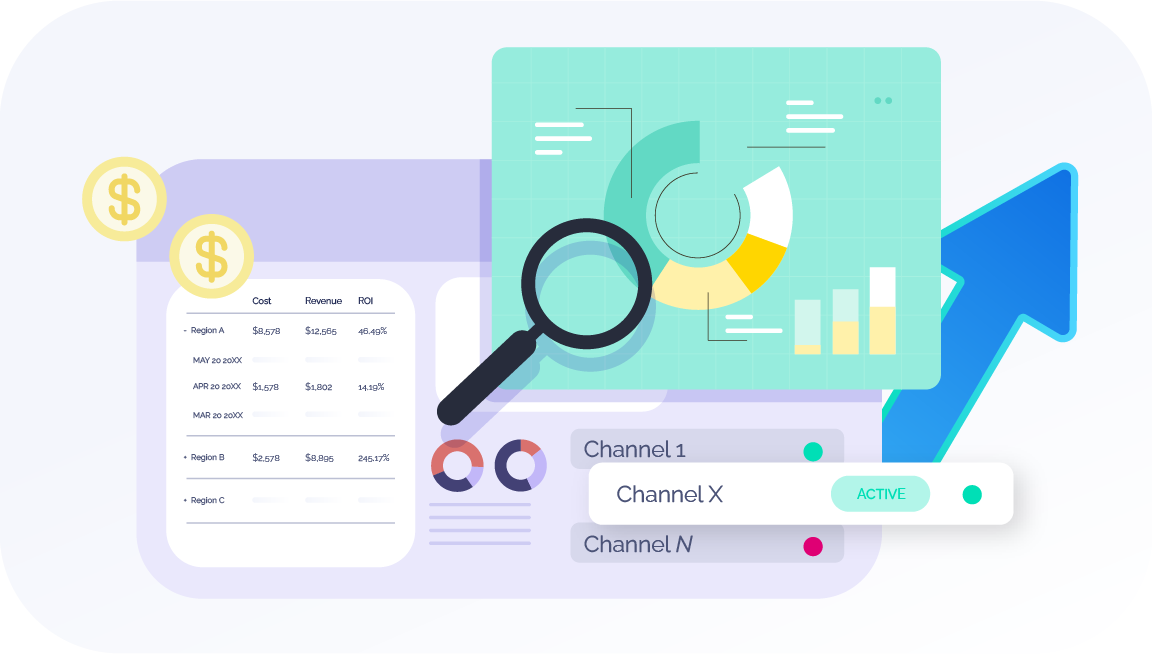Reducing user acquisition costs (UACs) is essential for maximizing return on investment (ROI) and achieving sustainable growth. It’s on nearly every one of Branch’s clients’ mobile marketing to-do lists for 2024 and beyond. Many leading brands, from MyFitnessPal to Rummy Passion, have turned to mobile measurement partner (MMP) data to refine their strategies and drive down costs.
In this blog, we’ll explore how you can leverage MMP data to enhance your user acquisition efforts and achieve more efficient spending. We’ll look at proven strategies to streamline campaigns and optimize resource allocation.
Understanding the role of MMPs in user acquisition
MMPs are crucial in the app ecosystem, offering insights into user acquisition and campaign performance. They track and attribute user interactions across various channels, allowing marketers to measure the effectiveness of their campaigns and understand user origins.
But their role extends beyond mere tracking; MMPs offer a comprehensive view of how users interact with an app across various channels, allowing app marketers to gain a deeper understanding of their acquisition strategies.
Comprehensive and unbiased data
One of the primary advantages of an MMP is its ability to provide unbiased data across both self-attributing networks (SANs) and non-self-attributing networks (non-SANs). SANs, including Google and Meta, are platforms that track and attribute user interactions themselves, which often gives a skewed view of their performance. Non-SANs, on the other hand, rely on third-party analytics tools to attribute interactions and in-app events.
With an MMP, you can aggregate and analyze mobile attribution data across all your ad networks, ensuring you get a balanced view of your marketing efforts. This helps prevent overreliance on any single network’s attribution model and provides a more accurate picture of overall performance.
Deduplicated data across paid and organic channels
Another important advantage of MMPs is their capability to deduplicate data across both paid and organic channels. Most enterprises run simultaneous campaigns across a multitude of channels, so integrating an MMP ensures that you’re tracking and attributing without duplication.
For instance, when users interact with your app through multiple touchpoints — such as clicking on a paid ad and later discovering your app through organic search — MMPs ensure that these interactions are accurately attributed and not counted multiple times. This level of precision helps you avoid the pitfalls of misattribution and provides a more accurate assessment of your user journeys and each channel’s performance.
Key strategies for reducing UACs
1. Diversify your channel spread
Relying solely on paid ads isn’t always the most effective way to acquire users or achieve app growth. In fact, in certain sectors like finance, Branch sees organic channels drive twice as many installs as paid ads. Diversifying your digital marketing channel spread can help you optimize your spend and tap into different sources of traffic. Take advantage of your owned channels where users are already engaging with your brand. For example, you can implement contextual calls to action (CTAs) on your mobile website or utilize desktop QR (quick response) code banners. This approach helps to maximize your existing traffic and often provides a more cost-effective way to reach potential users.
2. Regularly analyze attribution data
Attribution data sheds light on which touchpoints and channels drive conversions. Continuously analyzing this data helps you determine which sources are most effective for user acquisition and which ones are less impactful.
For example, if you find that users acquired through a specific ad network or referral source exhibit higher lifetime value (LTV) post-install, you can prioritize these channels and adjust your spending accordingly. Conversely, reducing or eliminating spend on underperforming channels can lead to cost savings.
3. Optimize campaign targeting
Refining your campaign targeting is a primary method for reducing UACs. MMPs provide detailed data on user demographics, behaviors, and engagement patterns. By analyzing this information, you can pinpoint high-performing segments and tailor your campaigns to attract users more likely to convert.
For instance, if your data indicates that a particular demographic or geographic segment yields a higher ROI, you can focus more budget on these segments and adjust targeting strategies for less effective ones.
4. Implement retargeting strategies
Retargeting is a powerful method for lowering UACs by reengaging users who have shown interest in your app but haven’t completed the desired action. MMP data allows you to segment these users based on their behavior and interactions, enabling you to create highly personalized retargeting campaigns.
By focusing on users who have previously engaged with your app, you increase the likelihood of conversion at a lower cost compared to acquiring new users. Retargeting maximizes the value of your existing user base and enhances overall campaign efficiency. For more insights on how retargeting has evolved, check out our blog on retargeting in a post-privacy world.
5. Test and iterate creative strategies
Creatives play a significant role in user acquisition, and MMP data provides insights into which creatives resonate most with your audience. By analyzing performance metrics such as click-through rates (CTRs), conversion rates, and engagement levels, you can identify the most effective creatives.
A/B testing different creative variations allows you to compare performance and refine your strategy based on data-driven insights. Continuously testing and iterating helps improve ad effectiveness and reduce UACs over time. Online entertainment database IMDb adopted this approach and conducted over 30 experiments, resulting in a 443% increase in app installs through their owned channels.
Integrating cost aggregation for comprehensive insights
It’s impossible to reduce UACs without a deep understanding of your spending and returns. Cost aggregation is crucial for getting a clear, actionable view of your acquisition campaign performance.
1. Unify cost and revenue insights
One effective way to manage and reduce UACs is through comprehensive cost aggregation. By consolidating cost data from various ad partners and integrating it with ad revenue insights, you gain a complete view of your advertising spend and ad campaign performance.
This unified approach helps you understand the impact of your marketing efforts by merging cost data with revenue and engagement metrics. By having a centralized dashboard to monitor key metrics like return on advertising spend (ROAS) and cost per action (CPA), you can make more informed decisions and optimize your ad spend effectively.
2. Ensure data accuracy and reliability
Accurate and reliable data is crucial for making confident investment decisions. Tools that provide real-time monitoring of your connections to ad partners alert you to potential issues and enable corrective actions to help maintain data integrity.
Leveraging these capabilities ensures that your cost and revenue insights are trustworthy, allowing you to make decisions based on comprehensive and accurate data. This approach improves advertising ROI and helps reduce UACs.
Integrating MMP insights into your acquisition strategy
To fully leverage MMP data and reduce UACs, integrate these insights into your overall acquisition strategy. Here’s how:
- Set clear objectives: Define your marketing strategy’s acquisition goals and key performance indicators (KPIs) to align your MMP data with your objectives. This clarity helps focus on the metrics that are most important for reducing UACs.
- Monitor performance regularly: Continuously track and analyze your MMP data to stay informed about marketing campaign performance and user behavior. Regular monitoring allows for timely adjustments and optimizations to improve results.
- Collaborate with your team: Share MMP insights with your marketing team and other stakeholders to ensure alignment and collaborative decision-making. This enhances overall campaign effectiveness and fosters data-driven strategies.
- Keep up with market changes: The mobile app landscape is dynamic, and user behavior can evolve. Stay agile and adapt your acquisition strategy based on changing data regulations and market trends.
Next steps
Reducing UACs is an ongoing process that requires a data-driven approach. By effectively leveraging MMP data and integrating comprehensive cost aggregation insights, you can optimize targeting, refine creatives, and make informed decisions that drive down costs and improve campaign performance. Embracing these insights will help achieve more efficient spending and drive sustainable growth for your app.
To learn how Branch can help you optimize your user acquisition strategies, reach out to our team.



